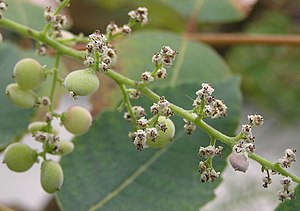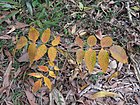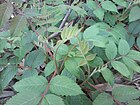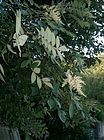Note: This is a project under development. The articles on this wiki are just being initiated and broadly incomplete. You can Help creating new pages.
Difference between revisions of "Rhus chinensis"
| Line 1: | Line 1: | ||
| − | + | [[File:鹽膚木 Rhus chinensis -香港西貢獅子會自然教育中心 Saikung, Hong Kong- (9240277384).jpg|thumb|right]] | |
| + | '''Rhus chinensis''' is a deciduous shrub or small tree with an open, spreading crown' it usually grows from 2 - 12 metres tall. The bole can be 6 - 18cm in diameter. The plant has an extensive root system and spreads by means of suckers, often forming thickets. | ||
| + | The tree has a range of uses including - producing an edible fruit; having medicinal properties; a source of tannins, dye plant and source of oil. It is gathered from the wild and mainly used locally. Galls produced as a result of insect activity on the plant are widely used medicinally in east Asia, especially in polyherbal preparations, and are often traded. | ||
==Uses== | ==Uses== | ||
| − | {{Uses|}}, {{Uses|}}, {{Uses|}}, {{Uses|}}, {{Uses|}}, {{Uses|}}, {{Uses|}}, {{Uses|}}, {{Uses|}}, {{Uses|}}, {{Uses|}}.<ref name="Uses"/> | + | {{Uses|Diarrhoea}}, {{Uses|Haemorrhage}}, {{Uses|Persistent cough}}, {{Uses|Spontaneous sweating}}, {{Uses|Night sweats}}, {{Uses|Bloody stool}}, {{Uses|Urorrhoea}}, {{Uses|Bloody sputum}}, {{Uses|Haemoptysis}}, {{Uses|Inflammations}}, {{Uses|Laryngitis}}.<ref name="Uses"/> |
==Parts Used== | ==Parts Used== | ||
| − | {{Parts Used| | + | {{Parts Used|Fruits}}. |
==Chemical Composition== | ==Chemical Composition== | ||
| − | <ref name="chemical composition"/> | + | Ten compounds were obtained: β-sitosterol (1), morolic acid (2), (2S) -1-O-heptatriacontanoyl glycerol (3), α-monpalmitin (4), palmitic acid (5), gallic acid (6), methyl gallate (7), ethyl gallate (8), propyl gallate (9), and protocatechuic acid (10)<ref name="chemical composition"/> |
==Common names== | ==Common names== | ||
| − | {{Common names|sa=|en=|gu=|hi=|kn=|ks=|ml=|mr=|pa=|ta=|te=}} | + | {{Common names|sa=|en=Chinese Sumac|gu=|hi=Tatri|kn=|ks=|ml=|mr=|pa=|ta=|te=}} |
==Properties== | ==Properties== | ||
| Line 28: | Line 30: | ||
==Habit== | ==Habit== | ||
| − | {{Habit|}} | + | {{Habit|Deciduous tree}} |
==Identification== | ==Identification== | ||
| Line 47: | Line 49: | ||
==Mode of Propagation== | ==Mode of Propagation== | ||
| − | {{Propagation|}} | + | {{Propagation|Seeds}}, {{Propagation|Cuttings of half-ripe wood}}, {{Propagation|Root cuttings}}, {{Propagation|Suckers}}. |
==How to plant/cultivate== | ==How to plant/cultivate== | ||
| − | <ref name="How to plant/cultivate"/> | + | Rhus chinensis is a plant of the warm temperate to tropical zones, found at elevations of 900 metres or more in Indonesia. It only has moderate cold-hardiness, tolerating short periods with temperatures down to around -8°c when it is fully dormant.<ref name="How to plant/cultivate"/> |
==Commonly seen growing in areas== | ==Commonly seen growing in areas== | ||
| − | {{Commonly seen|}}, {{Commonly seen|}}, {{Commonly seen|}}, {{Commonly seen| | + | {{Commonly seen|Mountain forests}}, {{Commonly seen|Forests along streams}}, {{Commonly seen|Thickets}}, {{Commonly seen|Secondary forest}}. |
==Photo Gallery== | ==Photo Gallery== | ||
<gallery class="left" caption="" widths="140px" heights="140px"> | <gallery class="left" caption="" widths="140px" heights="140px"> | ||
| − | + | Rhus chinensis sapling.jpg | |
| + | Rhus chinensis.jpg | ||
| + | Rhus javanica var chinensis1.jpg | ||
| + | Rhus javanica var chinensis2.jpg | ||
| + | Rhus javanica var chinensis3.jpg | ||
| + | 鹽膚木 Rhus chinensis -香港西貢獅子會自然教育中心 Saikung, Hong Kong- (9240277384).jpg | ||
</gallery> | </gallery> | ||
| Line 63: | Line 70: | ||
<references> | <references> | ||
| − | <ref name="chemical composition">[ | + | <ref name="chemical composition">[https://pubmed.ncbi.nlm.nih.gov/26762062/ Chemistry]</ref> |
| − | <ref name="Leaf">[ | + | <ref name="Leaf">[Morphology]</ref> |
| − | <ref name="How to plant/cultivate">[ | + | <ref name="How to plant/cultivate">[http://tropical.theferns.info/viewtropical.php?id=Rhus+chinensis Cultivation]</ref> |
<ref name="Uses">Indian Medicinal Plants by C.P.Khare</ref> | <ref name="Uses">Indian Medicinal Plants by C.P.Khare</ref> | ||
</references> | </references> | ||
==External Links== | ==External Links== | ||
| − | * [ ] | + | * [https://www.sciencedirect.com/science/article/abs/pii/S1876382018303846 Rhus chinensis on sciencedirect.com] |
| − | * [ ] | + | * [https://pfaf.org/user/Plant.aspx?LatinName=Rhus+chinensis Rhus chinensis on pfaf.org] |
| − | + | ||
[[Category:Herbs]] | [[Category:Herbs]] | ||
Latest revision as of 16:09, 31 July 2020
Rhus chinensis is a deciduous shrub or small tree with an open, spreading crown' it usually grows from 2 - 12 metres tall. The bole can be 6 - 18cm in diameter. The plant has an extensive root system and spreads by means of suckers, often forming thickets. The tree has a range of uses including - producing an edible fruit; having medicinal properties; a source of tannins, dye plant and source of oil. It is gathered from the wild and mainly used locally. Galls produced as a result of insect activity on the plant are widely used medicinally in east Asia, especially in polyherbal preparations, and are often traded.
Contents
- 1 Uses
- 2 Parts Used
- 3 Chemical Composition
- 4 Common names
- 5 Properties
- 6 Habit
- 7 Identification
- 8 List of Ayurvedic medicine in which the herb is used
- 9 Where to get the saplings
- 10 Mode of Propagation
- 11 How to plant/cultivate
- 12 Commonly seen growing in areas
- 13 Photo Gallery
- 14 References
- 15 External Links
Uses
Diarrhoea, Haemorrhage, Persistent cough, Spontaneous sweating, Night sweats, Bloody stool, Urorrhoea, Bloody sputum, Haemoptysis, Inflammations, Laryngitis.[1]
Parts Used
Chemical Composition
Ten compounds were obtained: β-sitosterol (1), morolic acid (2), (2S) -1-O-heptatriacontanoyl glycerol (3), α-monpalmitin (4), palmitic acid (5), gallic acid (6), methyl gallate (7), ethyl gallate (8), propyl gallate (9), and protocatechuic acid (10)[2]
Common names
| Language | Common name |
|---|---|
| Kannada | |
| Hindi | Tatri |
| Malayalam | |
| Tamil | |
| Telugu | |
| Marathi | |
| Gujarathi | |
| Punjabi | |
| Kashmiri | |
| Sanskrit | |
| English | Chinese Sumac |
Properties
Reference: Dravya - Substance, Rasa - Taste, Guna - Qualities, Veerya - Potency, Vipaka - Post-digesion effect, Karma - Pharmacological activity, Prabhava - Therepeutics.
Dravya
Rasa
Guna
Veerya
Vipaka
Karma
Prabhava
Habit
Identification
Leaf
| Kind | Shape | Feature |
|---|---|---|
Flower
| Type | Size | Color and composition | Stamen | More information |
|---|---|---|---|---|
| {{{5}}} |
Fruit
| Type | Size | Mass | Appearance | Seeds | More information |
|---|---|---|---|---|---|
Other features
List of Ayurvedic medicine in which the herb is used
Where to get the saplings
Mode of Propagation
Seeds, Cuttings of half-ripe wood, Root cuttings, Suckers.
How to plant/cultivate
Rhus chinensis is a plant of the warm temperate to tropical zones, found at elevations of 900 metres or more in Indonesia. It only has moderate cold-hardiness, tolerating short periods with temperatures down to around -8°c when it is fully dormant.[4]
Commonly seen growing in areas
Mountain forests, Forests along streams, Thickets, Secondary forest.
Photo Gallery
References
External Links
- Ayurvedic Herbs known to be helpful to treat Diarrhoea
- Ayurvedic Herbs known to be helpful to treat Haemorrhage
- Ayurvedic Herbs known to be helpful to treat Persistent cough
- Ayurvedic Herbs known to be helpful to treat Spontaneous sweating
- Ayurvedic Herbs known to be helpful to treat Night sweats
- Ayurvedic Herbs known to be helpful to treat Bloody stool
- Ayurvedic Herbs known to be helpful to treat Urorrhoea
- Ayurvedic Herbs known to be helpful to treat Bloody sputum
- Ayurvedic Herbs known to be helpful to treat Haemoptysis
- Ayurvedic Herbs known to be helpful to treat Inflammations
- Ayurvedic Herbs known to be helpful to treat Laryngitis
- Herbs with Fruits used in medicine
- Herbs with common name in Hindi
- Herbs with common name in English
- Habit - Deciduous tree
- Index of Plants which can be propagated by Seeds
- Index of Plants which can be propagated by Cuttings of half-ripe wood
- Index of Plants which can be propagated by Root cuttings
- Index of Plants which can be propagated by Suckers
- Herbs that are commonly seen in the region of Mountain forests
- Herbs that are commonly seen in the region of Forests along streams
- Herbs that are commonly seen in the region of Thickets
- Herbs that are commonly seen in the region of Secondary forest
- Herbs






